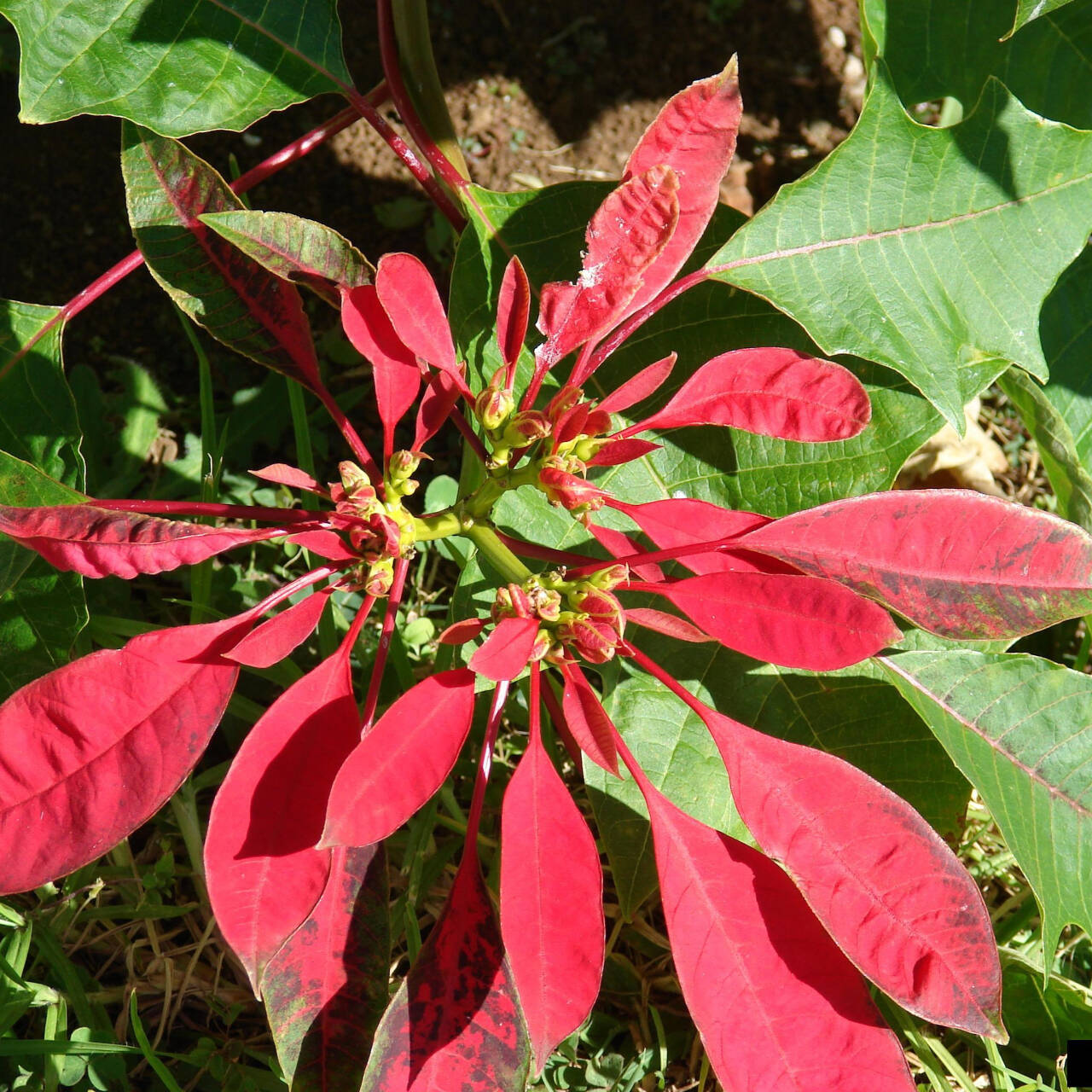It is widely believed that the poinsettia (scientific name: Euphorbia pulcherrima) was brought to the United States from Mexico in the late 1820s by its namesake, Joel Roberts Poinsett, the first ambassador to Mexico — or, perhaps, his associates.
Poinsettias now sold during the holiday season, however, only loosely resemble those originally brought to the United States.
In the second part of this two-part series, we will discuss the rags to riches transformation of the poinsettias enjoyed around the world each holiday season.
In the wild, the poinsettia is a tall shrub with scattered flowers and small brightly colored red bracts. In contrast, today’s commercially produced poinsettias are compact plants with large bracts in shades of red, pink, white, salmon, yellow, plum and maroon.
Some modern-day poinsettias have variegated or speckled bracts and some have curly or oddly shaped bracts.
(Note: Bracts are the colorful, petal-like leaves that surround the small cup-shaped true flowers of the poinsettia.)
Wild poinsettias also bloom too late for commercial distribution and sale in the U.S. for Christmas.
Crossing cultivars
Like many plants, many more commercially desirable cultivars of the poinsettia resulted from the laborious crossing of existing cultivars of E. pulcherrima. Seeds from these crosses were harvested, planted and observed. If the resulting offspring had desirable traits, they were propagated vegetatively for mass production.
Crossing poinsettia cultivars with other Euphorbia species has been another means of producing new poinsettia cultivars. Most recently, cultivars of E. pulcherrima were crossed with E. cornastra (the dogwood poinsettia); the resulting cultivars have more flower clusters, bracts with brighter colors and plants that do not lose their bracts as quickly as the parent poinsettia plants.
Some cultivars of poinsettia have resulted from the vegetative propagation of interesting “sports” on existing cultivars. A sport is a genetic mutation that arises at a growing tip of a plant that shows characteristics different from the plant from which it originates.
Sports can occur randomly or be induced by environmental exposures. In recent years, growers have exposed plants to gamma rays and x-rays to induce sports with unusual bract shapes and colors.
Manipulation of the population
To make poinsettia plants more compact and able to fit into a pot, commercial producers grow the plants under optimal conditions (e.g., bright light with adequate plant spacing). They also pinch back the plants and apply growth regulators.
A surprising means of making poinsettias more compact with more flowers is through infection of the plants with an unusual microorganism. For years growers and researchers observed that some poinsettia cultivars branched more freely than others. In separate efforts, a leading producer, Paul Ecke, Sr., and a graduate student, John Dole, found that grafting free-branching varieties of poinsettias onto restricted branching varieties resulted in the restricted branching plants developing more branches and flowers.
It was not until the mid-1990s that American plant pathologist, Dr. Ing-Ming Lee of the U.S. Department of Agriculture determined that infection with phytoplasma, a bacterium-like microorganism, was the reason the plants branched more freely. It was the first time that such an infection had been known to result in a commercially desirable plant trait, not a major crop loss.
Timing of flowering has also been the object of grower and researcher efforts. Poinsettia plants require long nights (12 hours or more) for four to six weeks to flower; these conditions are not naturally achieved in North America until late in the year – too late for commercial distribution.
To get the plants to bloom in time for Christmas sales, growers manipulate plant growing conditions; they use blackout cloths, artificial lighting, and temperature.
Recent advances in breeding also have led to cultivars that flower early enough in the season when exposed to natural day lengths in North America to meet sales requirements.
Selling the poinsettia
Clever marketing is the final piece in the poinsettia’s rise to prominence. Even though the plant bloomed in winter, it was not associated with the holiday season by most Americans through the mid-1950s. That changed in the early 1960s when Paul Ecke, Jr. and his family skillfully promoted the poinsettia as a holiday standard through clever product placement.
Ecke sent free plants to television stations for display on air from Thanksgiving to Christmas. He appeared on television programs like “The Tonight Show” and “Bob Hope’s Christmas Special” to promote the plants. He even produced a select crop of poinsettias that bloomed in the summer so that it could be used in holiday photo shoots by magazines such as Sunset and Women’s Day that took place in the summer.
Through the efforts of many, the poinsettia has become a fabulous (and at times flamboyant) American holiday tradition and the most commercially valuable potted plant in the United States.
Will it adorn your home this holiday season?
Jeanette Stehr-Green is a WSU-certified Clallam County Master Gardener.
2024 calendars available
2024 Master Gardener Foundation of Clallam County calendars are available now! The calendar offers beautiful full-page photographs and monthly gardening tips as well as reminders of upcoming gardening events, workshops and talks.
Calendars are $8 for one or $7.50 each for orders of two or more.
To purchase a calendar, go to:
• Master Gardener Woodcock Demonstration Garden, 2711 Woodcock Road, between 10 a.m.-noon on Thursdays
• Fiddleheads Home & Garden, 124 W. First Street, Suite B, Port Angeles; call 360-452-2114 for hours
• Purchase by mail-order option: Visit clallammgf.org and follow the prompts, or send a check made out to: Clallam Master Gardener Foundation/Master Gardener Program, Attn: Harmony Rutter, 1914 West 18th Street, Port Angeles, WA 98363.


